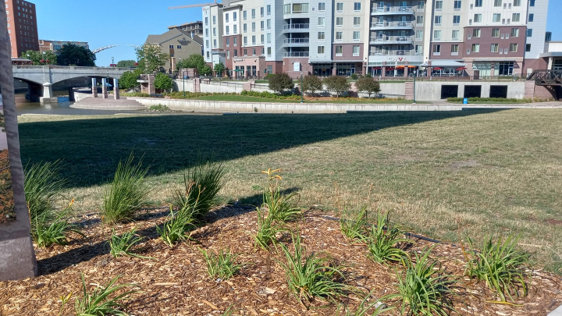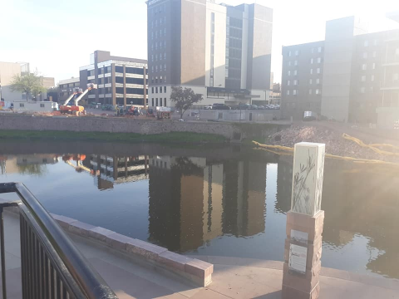
THE LONG LOST SECOND ISLAND

THE HISTORY OF THE LONG LOST SECOND ISLAND ON THE BIG SIOUX RIVER
By: Mike Zitterich
Once upon a time, the City Of Sioux Falls had two major islands within the main business district of the Town. The first, and the largest, and the more famous of the two was Brookings Island or what became to be known today as Seney Island which stands today below the Sioux Steel Property being developed into commercial real estate. The Second, and least known was, well, "Second Island". It is this island, of which I would like to tell its story today.
Second Island, which received its name primarily because it was the 2nd largest of the two islands on the river, as it passed through Sioux Falls proper, was located at the junction of where 9th Street and Second Avenue come together in Downtown Sioux Falls. It may have been the smaller island, but it was large enough to hold citywide events on it, and for more than eighty years, it did just that.
First, we must tell the history of how the city came to be - as two groups of people came to the area between 1840 and 1850 to explore, settle, and search for land to build their commercial power house, the Falls on the Big Sioux River became the center attraction. First we enter into the equation the Western Town Company which was a group of land surveyors from Dubuque, Iowa. It was a company who would purchase roughly 160 acres of land under the 1841 Preemption Act, which was a settlement act that allowed settlers to seek out and squat on a piece of land, with the intent to claim it, patent it, and develop it. By 1856, the company was able to purchase the rights to the land just south of the Falls between 3rd Street south to 7th Street. For those who know this area, this is predominantly the same property of which held Sioux Steel, Pitts Steel, Ravens Industries, and the Railroad Yard, and more famously, this group of settlers would occupy, and hold the rights to Seney Island.
By 1862, a second group of investors, the Dakota Land Company would come to the area with the same intention, they became the second group of settlers to want to form a city, and they would essentially claim the land between 7th Street, going south to 12th Street which if you know your city map, Downtown Sioux Falls later on as the city grew in population. They would occupy what became known as "Second Island", and how fittingly, since the Dakota Land Company was the second group of settlers to explore, and settle the area.
While the Western Town Company established it's Townsite known as Sioux Falls in 1856, during the 1860's the two groups would work together to form Sioux Falls City by combining their two settlements to form one big city, of which they Dakota Land Company would build "Fort Sod" to protect the residents in the event of a Indian strike, the Fort of course was to be built on the property, that today the parking lot Great Western Bank building, directly southwest of Second Island.
Between 1881 and 1920 - Second Island, like its sister island to the south, was fast becoming a popular destination for residents, who oftentimes would hold picnics on the island. But unlike Seney, this island would soon hold a small building which would double as a Dance Hall, Concert Venue, Roller-skating Rink, and Mess Hall. The island itself had a small 'western channel' that went around its western boundary.
The "west bank" of the Sioux River as it passed through what quickly became Downtown Sioux Falls, was often times the lowest point along the river, it often flooded, which led to some desperate times for local businesses, homeowners, all who claimed properties in that area of town, and by the 1930's, plans were being put into motion to quickly redevelop and completely change this area for the future.
By 1936, work began on building the massive stone flood walls which you can see today, this would bring in with it tons and tons of dirt, gravel, and fill in order to fill in the land behind the wall. Yes, this meant the plan was to raise the land behind the wall, which would then usher in the newly adopted "Urban Development" of the 1940's which would bring with it new buildings, and of course by to cap it off in 1965, the River Ramp. Gone was the island, but in its place the 9th Street Extension which allowed for traffic to connect to 2nd Avenue, heading southbound to 14th Street.
Today, the picture below, is what Second Island appears like today, as you can see, the Island is still there, if you know where to look, located between the two Flood Gates in the wall, one located behind the former Western Bank building, and the other gate next to the Rock Island Railroad Bridge, and yes, the two gates do mark the points of which the former western channel connected to the river on both sides of the island.

From 1965 to 2009 - the River Ramp stood over the island itself, then with a new plan to again, redevelop Downtown, and to build the River River Greenway Project, the ramp was removed, and once again, the former island was again able to show some sign of life again, despite the fact it is 10 feet beneath the surface today. But if you look closely, you can see the island itself. You can also see a tale of two lives, for one, beneath the flood wall, is what the landscape used to look like, and behind the wall, you see the higher, filled in embankment which led to the Urban Development of the 1940's.
Western Channel Outflow to the River!
Western Channel Intake from the River!
Two Islands - Seney Island which represents the Western Town Company's property, and then there is Second Island which represents the Dakota Land Company's property, whereas today, we have this well planned out, and awesome Downtown Sioux Falls, the center attraction to the City of Sioux Falls, and what has become financial commercial hub of the State of South Dakota.
According to Grant K. Anderson's book titled " The Politics of Land in Dakota Territory: Early Skirmishes—1857-1861" of which he wrote about the time of which Sioux Falls was established, we now know the men, behind the establishment of what became the City of Sioux Falls:
Western Town Company (Company A)
Wilmot W. Brookings. Brookings set out for Dakota Territory in June of 1857. He arrived at Sioux Falls on August 27, 1857, and became one of the first settlers there. He and his group represented the Western Town Company quickly formed and established the Sioux Falls City, along with many investors of the Dakota Land Company, quickly with the help of both groups, despite a small hiccup between 1866-1871, With the help of his dear friend Richard F. Pettigrew, Sioux Falls quickly became, the commercial hub of what became the State of South Dakota.
Dakota Land Company (Company B)
Governor Samuel Medary approved the charter on 23 May 1857. Contemporaries portrayed the Dakota Land Company as a "company of gentlemen, principally residents of St. Paul,"' who "represented some of the leading capitalists of New England."* Listed among the incorporators were Samuel A. Medary, William H. Nobles, Joseph R. Brown, Alpheus G. Fuller, Jefferson P. Kidder, Samuel J. Albright, Byron M. Smith, Judge Charles E. Flandrau, James M. Allen, Franklin J. DeWitt, N. R. Brown, and James W. Lynd. Most were professional politicians active in Minnesota Territorial affairs, and several were destined to play roles in the development of Dakota Territory. All original incorporators of the Dakota Land Company professed strong Democratic convictions....The Dakota Land Company was quick to realize the profits available. With their political ties to the Democratic administration in Washington, company promoters thought territorial status could be achieved for this western area. Judge Charles E. Flandrau explained that the speculators hoped to "avail themselves of the advantages of being proprietors of the capital city and several lesser ones, that might become the seats of the university, penitentiary, and other public institutions."" There was also the matter of a host of appointive jobs that accompanied any new territory. The capitalists envisioned a monopoly, not just of land but of governmental offices as well, if they secured an organic act for Dakota Territory.
Together, Wilmont W. Brookings, Richard Pettigrew, Samuel Medary, all became the early leaders of what has become one of America's fastest growing "Cities' in the upper midwest. And two uniquely positioned islands, Seney Island near Falls Park, and Second Island near 9th Street and Second Avenue both played a huge role in the early development of the City of Sioux Falls today.
Here is a Facebook Live Video I made showing the exact spot of the legendary "Second Island" - https://www.facebook.com/688245340/videos/3067038806920020/

